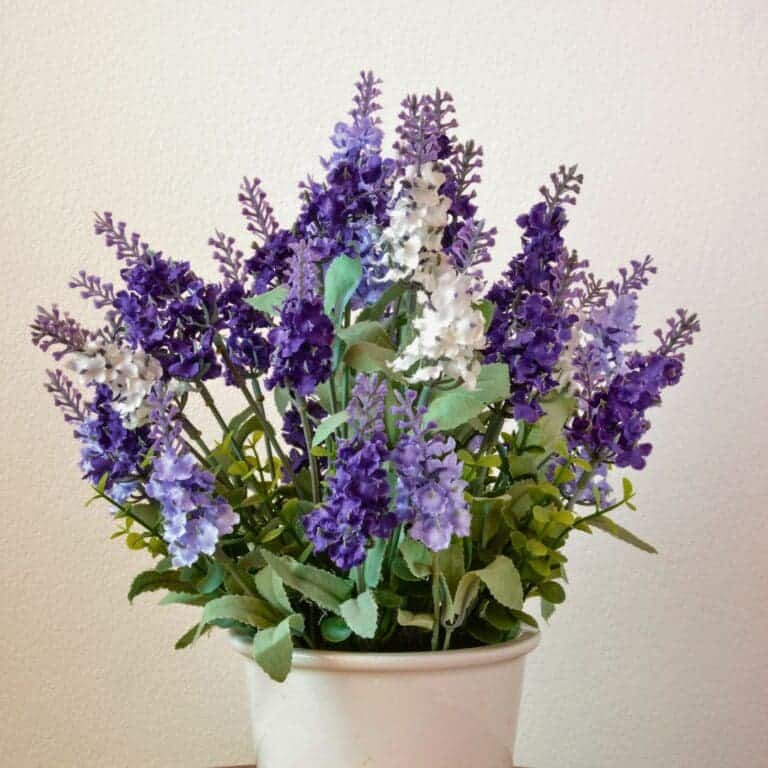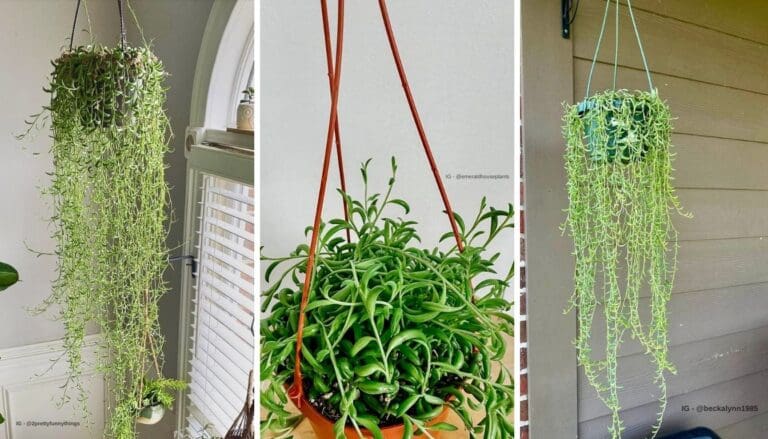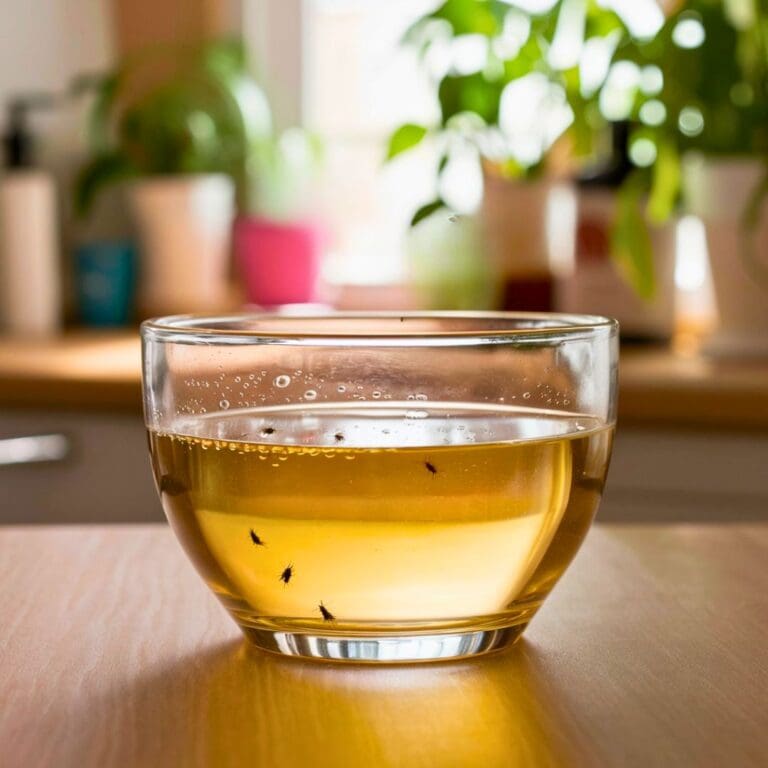9 Care Tips for Begonia Maculata(Polka Dot Begonia Plant)
Begonia Maculata, also known as the Polka Dot Begonia, is a true show-stopper with its whimsical spotted leaves and elegant blooms. I’ve always been drawn to plants that not only brighten up the space but also add a splash of character, and let me tell you, this plant has personality in spades! 🌿✨
Seriously, who can resist those playful polka dots?
Caring for these beauties might seem daunting at first, but it’s pretty straightforward once you get the hang of it.
Bright indirect light is their jam, and well-draining soil? Non-negotiable.
I keep mine near an east-facing window where it gets that gentle morning sun, and I’ve noticed it really thrives there.
Whether you’re a seasoned plant parent or a budding green thumb, the Begonia Maculata is a rewarding addition to your indoor jungle.
Ever caught yourself chatting with your plants, or is it just me? 😄 I can’t help but think they love the attention!
And when it comes to watering, I like to wait until the top inch of the soil feels dry – it’s like they’re telling me, “Thirsty over here!”
Remember, these plants are more about consistency than drenching surprises.
How do you keep your Begonia Maculata happy and hydrated? Share your tips in the comments – I’d love to hear what works for you!

Please note: Simplify Plants is reader-supported. As an Amazon Associate, I earn from qualifying purchases made by our readers with no extra cost added to you all! Some links in the post are affiliate links and I get a commission from purchases made through links in the post.
Understanding Begonia Maculata
Are you ready to get up close and personal with the ever-so-charming Begonia Maculata? Let’s dive into what makes this plant a standout in the houseplant community.
Begonia Maculata, often nicknamed the Polka Dot or Trout Begonia, is pretty much like the cool kid of the plant world with its snazzy spots and sassy leaf shapes.
Sporting those signature silver polka dots against a backdrop of rich green, it’s easy to see why it’s a fan favorite for spicing up living spaces!
Here’s a little fact sheet to give you a quick overview:
- Common Names: Polka Dot Begonia, Trout Begonia
- Leaf Description: Dark green with silvery-white spots
- Flowering: Yes, they produce delicate flowers
- Light Requirements: Prefers partial or indirect sunlight
- Watering Needs: Only when topsoil feels dry, beware of overwatering!
Are you giving it enough light, or is it stretching out to say “Give me more”?
Does your Begonia’s watering schedule mimic a desert rainfall or a tropical monsoon?
Getting these right means a happy plant that will brighten your home like no filter ever could! 😄
Can you already picture where in your home this stylish vegetal accessory would look best?
Have you got a Begonia Maculata story to share? Maybe a quirky nickname for your spotty leaf friend?
Give me a shout-out in the comments—I can hardly wait to swap tales from the urban jungle! 🌿🏙️
Proper Lighting Conditions
Before we dive into making your Begonia Maculata the envy of the plant community, let’s shine a light on what makes this polka-dotted beauty thrive. Proper lighting is like the perfect selfie spot – it just makes everything look better!
Identifying Ideal Light Exposure
So, you’re ready to find your Begonia Maculata’s spotlight?
Remember, these stunners love the limelight, but not too direct!
Think about a nice, cozy spot near a window with sheer curtains – you know, filtered sunlight. That way, your plant gets to bask in the glory without getting a sunburn (yes, plants can get that too!).
- Morning Light: It’s like a gentle wake-up call with a cup of coffee.
- Indirect Light: Like reading under a tree on a sunny day, it’s all about that dappled shade.
- Avoid Afternoon Sun: That’s the harsh blockbuster spotlight – a bit too intense!
🌿 Question: How do you balance a sunbathing session with not scorching your skin? Share your sun-soaking secrets below!
Signs of Poor Lighting
Let’s get real; I’ve seen my Begonia Maculata throw a fit when the lighting isn’t up to par. Keep an eye out for these telltale signs:
- Leggy Stems: Like a pair of pants that are too long, you’ll know something’s up.
- Fading Leaves: If your plant’s leaves are more faded than my jeans, it’s time to rethink your lighting strategy.
- Too Much Light: Leaves that look like they’ve seen a ghost? Too bright, my friend!
- Too Little Light: Sparse leaves whispering “feed me light”? Yep, it’s craving some rays.
Have you caught your Begonia Maculata sending S.O.S. signals? Tell me your own lighting mishaps down below, and let’s swap some war stories! ⚡😉
Lastly, don’t be shy to share this with your leaf-loving pals – a little light might just make their day, too! 🌞🌱
Watering Your Begonia Maculata
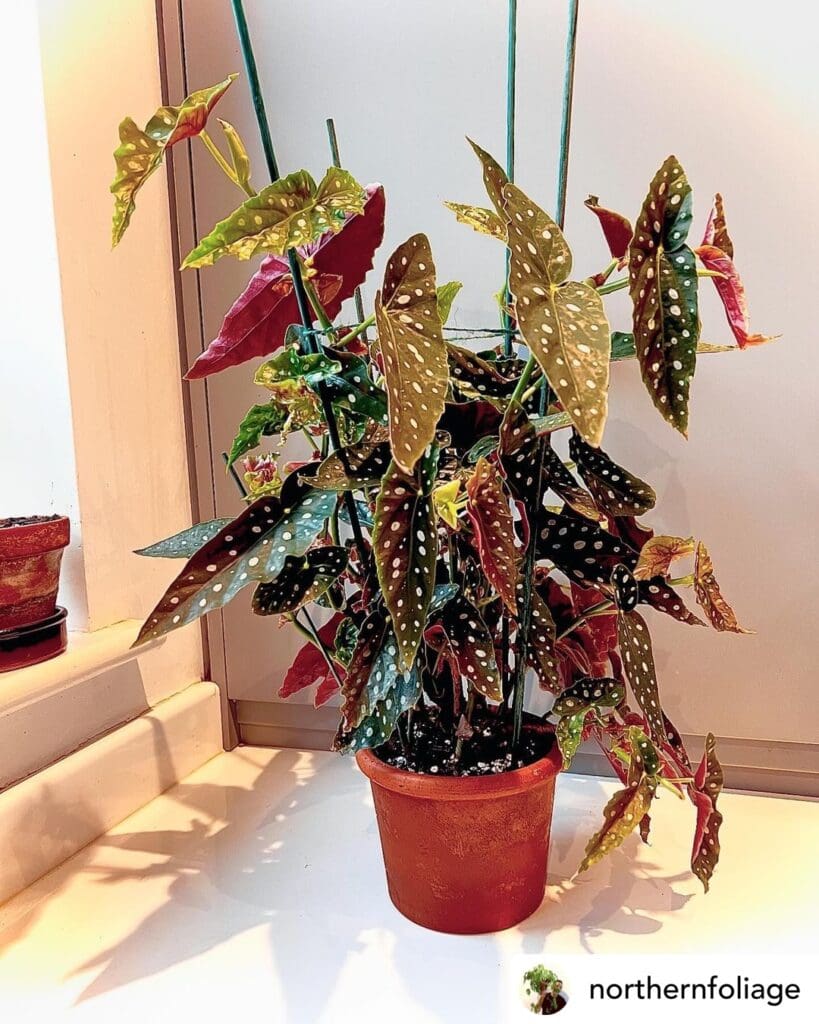
I’ve discovered that keeping your Begonia Maculata perfectly quenched is more of an art than a science. My key point? Don’t drown it in love—moderation is the secret sauce!
Watering Techniques
Water me, but not too much! When the top 1/2 inch of the soil feels drier than a day without sunshine, it’s time to grab that watering can.
Ensure thorough watering until it drains out the bottom, but never let my feet soak in a puddle.
Bottom Watering vs Top Watering
Are you Team Top or Team Bottom when it comes to watering?
Top watering is like a gentle rain on a summer day for me. Just pour evenly and let the shower do its magic.
Now, bottom watering is like a spa day; I soak up just what I need from below. Some say it’s neat and reduces the risk of leaf diseases. 🛀
Recognizing Overwatering and Underwatering
Can you tell when I’m thirstier than a cactus in the desert or more waterlogged than a sponge in the ocean?
If my leaves are more droopy than a teenager on Monday morning, it’s SOS time. But! If they’re turning yellow, I might be getting more water than ducks in a pond. Keep a keen eye on me! 👀
So, got any watering war stories or triumphs of your own to share? Drop them in the comments!
And if you think this advice just might make the difference between a Begonia Maculata that survives and one that thrives, go ahead and sprinkle this post into your friends’ feeds! 🌱💦
Fertilizing Schedule
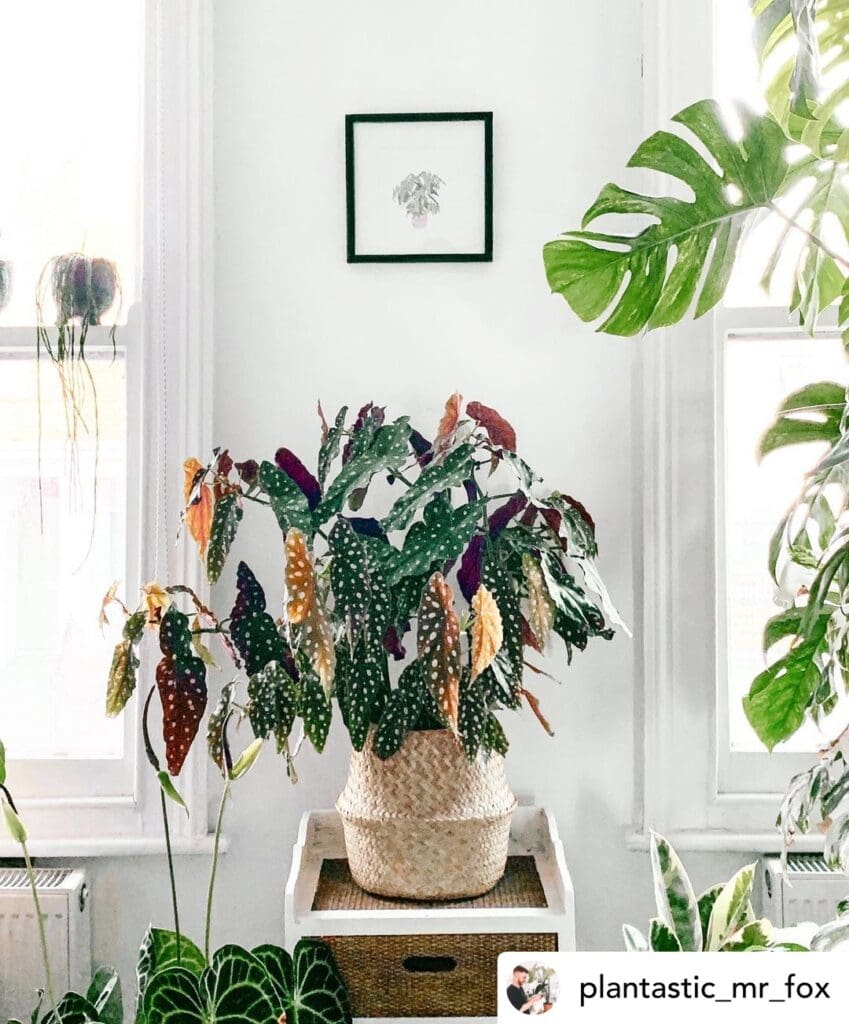
Let’s talk fertilizer for our show-stopping Begonia Maculata. I’m honing in on what makes our polka-dotted friends thrive—let’s dive straight into the nitty-gritty of their dining preferences!
Choosing the Right Fertilizer
When it comes to fertilizer, I like to think of it as the gourmet meal for my Begonia Maculata! A balanced, water-soluble fertilizer is the way to go.
Ideally, it should have an equal ratio of nitrogen, phosphorus, and potassium (look for numbers like 10-10-10 or 20-20-20 on the package).
Remember, the right nutrients mean more vibrant spots!
- Nitrogen (N): For lush leaf growth
- Phosphorus (P): To boost healthy roots and flowers
- Potassium (K): For overall vitality and disease resistance
Application Frequency
I’ve found that less is more when feeding my Begonia maculata—it’s easy to get carried away!
During the growing season (spring to fall), I serve up a half-strength dose of this fertilizer once a month.
It’s like a monthly spa treatment, keeping my Begonia looking its best! In the winter, it’s their time off. They’re snoozing, so no fertilizer is needed.
Keep it simple and mark your calendar, so you don’t miss a feast! 📆
Have you got any fertilizer tips or tricks up your gardening gloves? Drop your thoughts and let’s get the fertilizer party started in the comments below! 🎉
Remember to keep it excellent and share this article with your plant-loving buddies—happy growing! 🌱
Temperature and Humidity Requirements
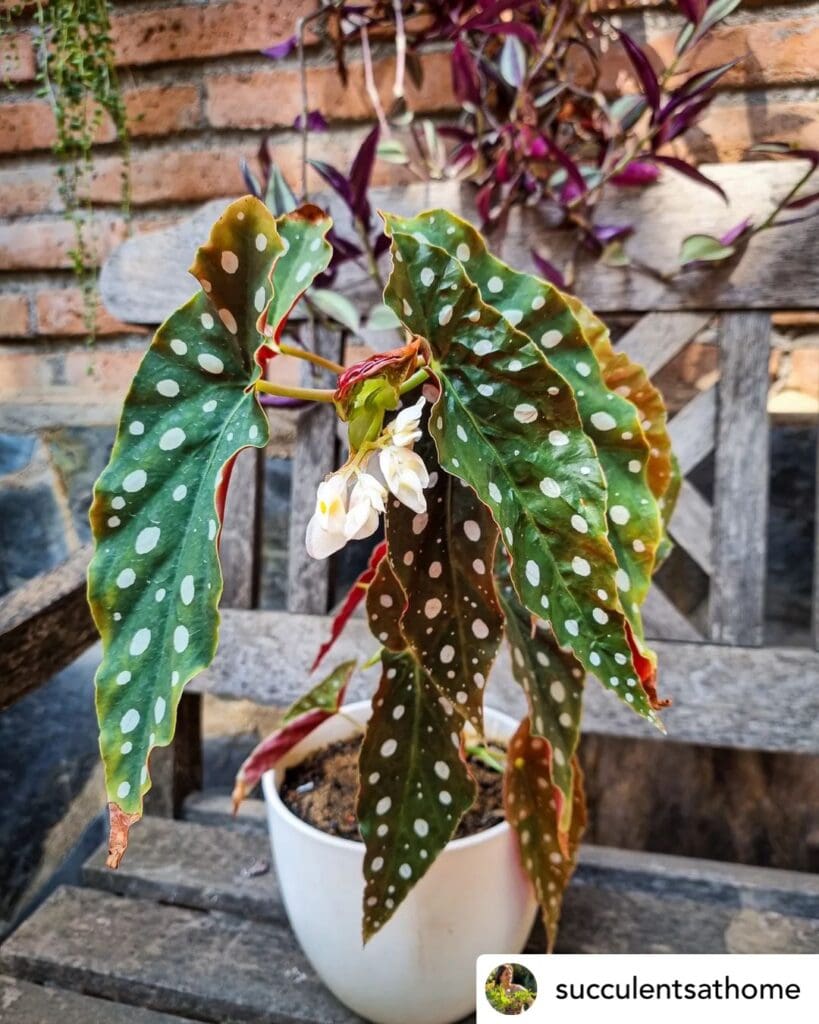
If you’re keen on keeping your Begonia Maculata thriving, nailing the right temperature and humidity is like hitting the jackpot.
Who wouldn’t want their polka dot beauty to feel right at home?
Ideal Temperature Ranges
My Begonia Maculata pals prefer to stay cozy in temperatures between 65 – 80°F (18.3 – 26.7°C). It’s like their comfort zone for lounging around.
Hotter or colder, and they may throw a tantrum (read: drop leaves). So, if your home’s climate mimics a tropical paradise, your begonia is in for a treat!
Optimal Humidity Levels
Now, let’s chat about humidity. Begonia Maculata needs a party atmosphere — think humidity of 50% or higher.
It’s like they enjoy their air as we like our spa days, moist and refreshing.
If your air’s drier than my sense of humor on a Monday morning, consider a humidifier to crank up the vibe.
Got any tips or fun stories about your Begonia Maculata’s luxurious humidity and temperature spa routine? Drop a comment and let me in on your secrets! 💬👀
Pruning and Maintenance
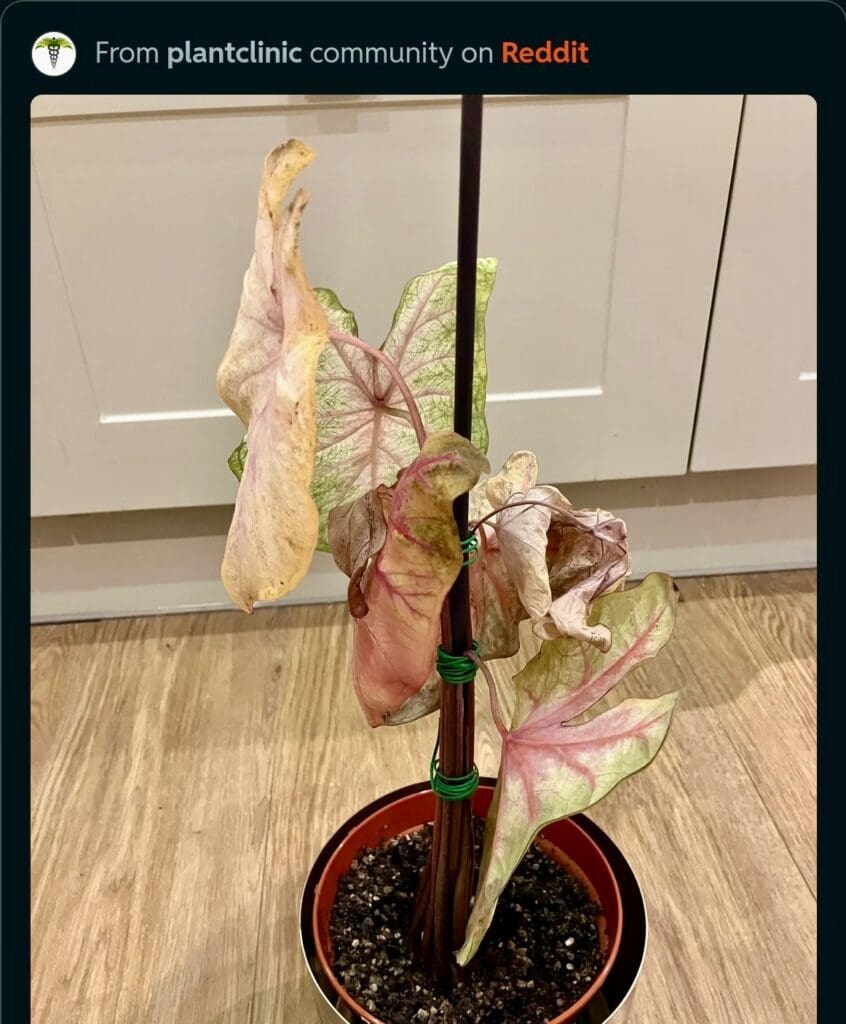
I’ve discovered that keeping my Begonia Maculata in shape is crucial for a lush, vibrant appearance. Let’s dive into the nitty-gritty of pruning and maintenance to keep our polka-dotted friends looking their best!
How to Prune
Pruning is like giving your Begonia a spa treatment! I start by snipping off any dead or dying leaves at the stem base, which encourages new growth.
Remember: Always use sterile, sharp scissors to make clean cuts.
In the spring and summer, when my Begonia is in its active growing phase, I trim back any leggy stems to maintain a compact and bushy form. 🌸
Cleaning the Leaves
Now, who doesn’t appreciate a nice leaf shine? To keep my Begonia’s leaves dust-free and spotless, I wipe them gently with a soft, damp cloth.
This not only makes them sparkle but also improves photosynthesis. It’s a win-win!
Just be extra kind to those delicate spotted leaves; we don’t want to wipe away their charm. ✨
Have you given your Begonia Maculata a trim lately? Share your before and after photos or your go-to maintenance tips in the comments below. Let’s keep the Begonia buzz going! 🐝
Repotting Guidelines
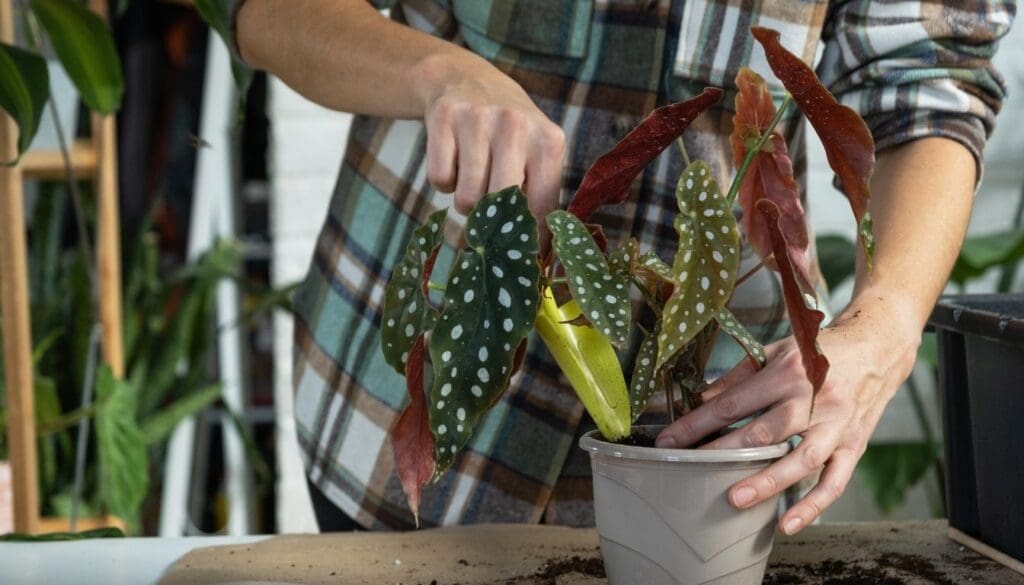
Have you ever wondered if you’re giving your Begonia Maculata the space it needs to strut its stuff? 🌿
Repotting doesn’t have to be a headache—if you know when to do it and what to use, it can be as easy as pie! Let’s dive into the when and how of giving your polka dot pal a comfy new home.
When To Repot
I find the best time to repot Begonia Maculata is when it’s showing signs of being root-bound.
How can you tell? If the roots are poking through the drainage holes like curious little worms or the growth seems to have stalled, it’s time for a change! 🕵️♂️
Typically, checking in spring will give you a good idea if it’s go-time.
Choosing Soil and Pot
Getting the soil mix right is crucial—I like to use a blend that’s one part global traveler, two parts homebody.
Translation: a light, well-draining soil with a touch of perlite (70% potting mix to 30% perlite, to be exact). It’s like the perfect travel pillow for roots, providing comfort and support! 🌱
Now, let’s talk pots.
Make sure your new pot has drainage holes (a bathtub moment is not what we’re going for).
Size-wise, you’ll want to go just a bit larger than the current one—think of it as getting a new pair of shoes for a growing kid. Too big, and they’ll trip; too small, and ouch! 😬
So, I’ve shared my repotting secrets—what are yours? Drop a comment below and let’s swap tales from the gardening trenches! 📢
Dealing with Pests and Diseases
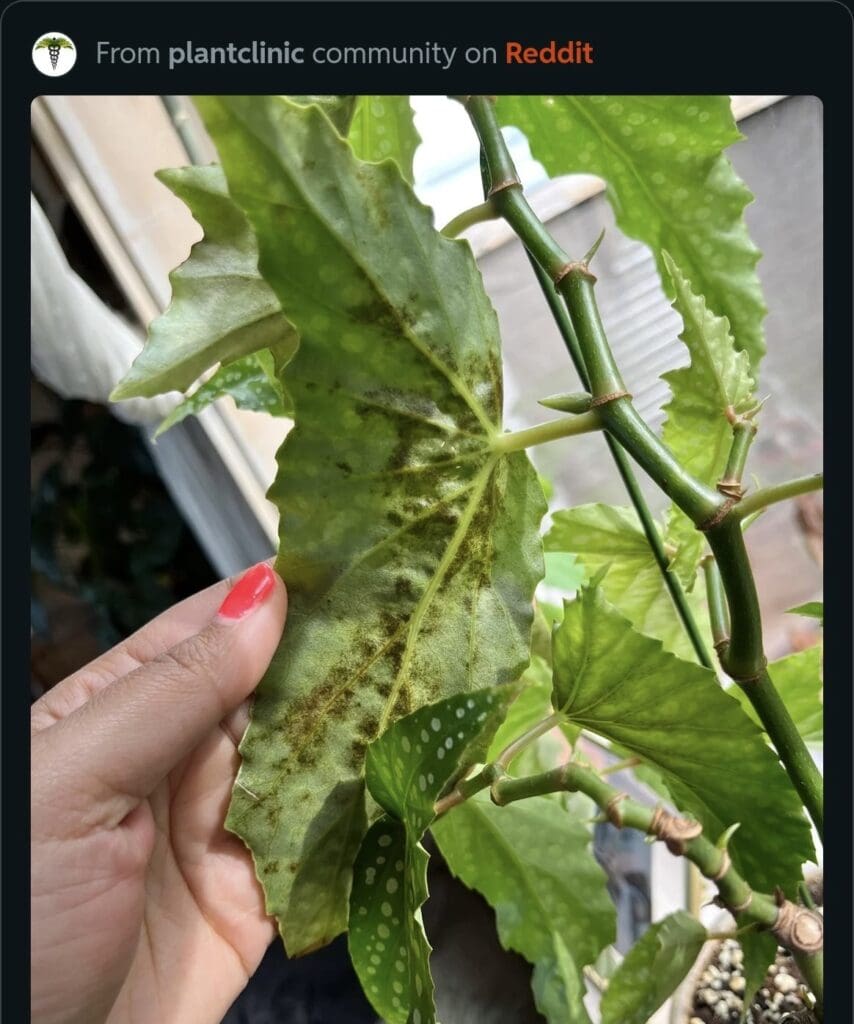
Keeping your Begonia Maculata happy means staying vigilant about pests and diseases. A bit of effort can prevent your plant from becoming a bug buffet or a moldy mess!
Common Pests
Mealybugs, spider mites, and aphids—oh my! These are the little critters I often find trying to set up camp on my Begonia.
Check under leaves and around stems for these unwelcome guests.
- Mealybugs: Look like tiny cotton swabs and love to suck on plant juices.
- Spider Mites: Tiny and hard to see, but they leave telltale webbing.
- Aphids: Small and green, yellow, or black, and they can be quite the juice thieves too!
Common Diseases
Fungal infections, like powdery mildew, and bacterial wilts can also be party poopers for your polka-dotted friend. Spot them early by checking for:
- Powdery Mildew: It’s like your plant got dusted with flour. Not the baking kind!
- Bacterial Wilts: If your plant starts to droop like it stayed up too late binge-watching, it might be sick.
Preventative Measures
An ounce of prevention is worth a pound of cure, right? Especially when it’s about my precious Begonia Maculata. I find these steps super helpful:
- Inspect Regularly: Make a habit of peeking at your plant regularly.
- Good Circulation: Keep the air moving around your plant, but not too drafty!
- Cleanliness: Keep your plant’s area tidy—spilled soil can harbor pests and diseases.
And remember, if you’ve got your own tips or tricks, or a story about saving your Begonia from the brink, I’d love to hear it in the comments. 🌱☺️ Don’t forget to keep those leaves clean and shiny for the ‘gram! #PolkaDotPlant #PlantParenthood
Propagating Begonia Maculata
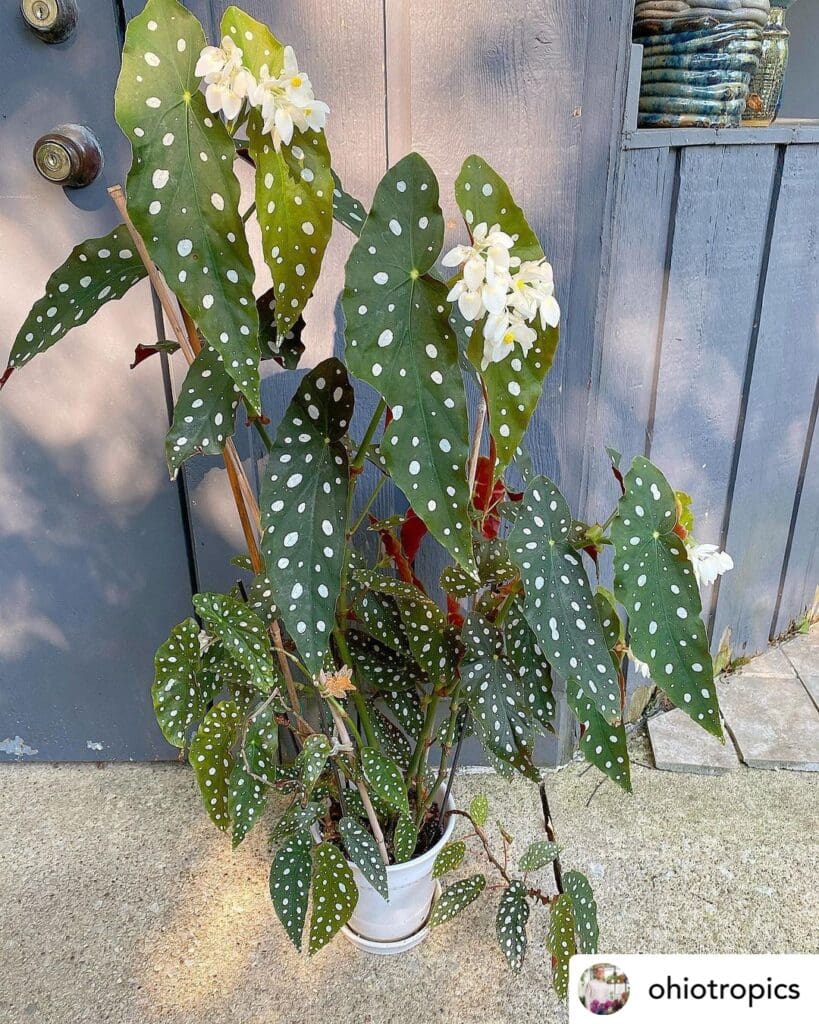
I just love seeing new growth sprout from my Begonia Maculata – it’s like a mini celebration in my plant corner! Here’s a cheat sheet for you to join in on the fun.
Propagation Methods
First things first, let’s choose the method that suits you best.
If you’re like me and enjoy a little daily root progress show, you’ll love the water propagation method. It’s quite simple:
- Snip a stem:
- Find a healthy stem with one or two nodes (that’s where the magic happens).
- Make a clean cut with sanitized scissors just below a node.
- Place in water:
- Use a clear container filled with water.
- Ensure at least one node is submerged, but keep the leaves out of the water to avoid rot.
- Wait for roots:
- Roots should show up in a couple of weeks 🌱.
For soil fans, you can stick the cutting in a pot with high-quality, well-draining potting mix. Just make sure to keep the soil moist but not waterlogged.
Care for New Plants
Got roots? Congrats! You’re almost there. 🎉 Now, let’s talk about the after-party care for these babies.
- Potting: When roots are about an inch long, it’s time to move them to soil.
- Light: They love bright but indirect light. Think of a cozy spot away from the intense afternoon sun.
- Water: Be consistent with moisture but don’t overdo it. I touch the soil; if the top is dry, it’s time for a drink.
- Humidity: A pebble tray or occasional misting can give them the humidity boost they need.
Remember, the new plants are just like youngsters – they need attention and care to thrive. I promise it’s worth it, seeing those polka-dotted beauties flourish.
Now, what about you? Have you tried propagating your Begonia Maculata? I’d love to hear your stories and see your pics in the comments. Happy propagating! 🌿✂️
Troubleshooting Common Issues

Sometimes, even the greenest thumbs encounter a little trouble in plant paradise. Here’s how I keep my Begonia Maculata thriving through common issues.
Yellowing Leaves
Have you ever seen yellow leaves on your Begonia and thought, “Oops, what’s up, buddy?” Usually, it means I’ve gotten a little too generous with the water. 💦
My fix? Let the soil dry out a bit before giving it another drink.
Drooping Stems
If your Begonia’s stems are drooping, it might be telling you it’s thirsty.
Before I panic, I check the soil moisture. If it’s dry, I give it a sip, ensuring not to overdo it!
Spotted or Discolored Foliage
Spotted leaves? No polka-dot patterns this time! This could mean too much direct sunlight 😎 or a fungal issue.
I move my plant to an area with indirect light and might use a fungicide if I suspect a fungus party.
Dying plant
A dying Begonia Maculata is the ultimate SOS!
I start by checking everything: light, water, pests, the works. Getting these factors right usually brings my Begonia back from plant heaven’s gates.
Conclusion
Caring for my Begonia Maculata – often affectionately called a ‘Polka Dot’ Begonia – is a cinch once you get the hang of it! Your Begonia will thrive if you remember these few simple tips:
- Sunlight: A spot with indirect light keeps those leaves with their characteristic silvery polka dots looking fabulous! Too much direct sun, and we could have a crispy leaf situation on our hands! 😅
- Watering: I like to water mine when the top inch of soil feels like a dry cake—crumbly and ready for a drink! Overwatering? Nope, not in my house. Don’t let our Begonia buddies sit in water; they’re not fans of soggy boots. 💦
- Humidity: These plants are a bit like us when winter hits – they enjoy a little extra moisture in the air! But unlike me needing a tropical vacation, a simple humidifier or a pebble tray with water does the trick. 🌬️
- Soil: Begonias adore a good, well-draining potting mix. Think of it like their favorite pair of comfy jeans—stable, supportive, yet totally breathable.
Remember, every plant has its own personality, and your Begonia Maculata is no exception. Got any success stories or funny anecdotes about your plant babies? Or perhaps a tip or two I missed? Drop your thoughts below—I’d love to hear about your green thumb adventures! 🌿😊
And hey, if you found this guide helpful, why not give it a share with fellow plant lovers? The more the merrier in our plant-caretaking community!
FAQs
Got Begonia Maculata questions? I’ve got answers! 🌿 Let’s dive in!
How often should I water my Begonia Maculata?
Watering can be tricky, right? I’ve found that letting the top 1/2 inch of soil dry before giving my Begonia a good soak is the sweet spot. Make sure to drain that excess water—no soggy plant feet here!
- Light requirements? Partial or indirect sunlight keeps my Begonia maculata happy. An east or west window? Perfecto! 🌞
- Best soil mixture? A well-draining potting mix is your begonia’s best friend. Think sandy clay or loamy soil that lets those roots breathe.
- How to propagate? Stem cuttings are the way to go! Snip a healthy piece, dip it in rooting hormone, and pop it into moist soil. Keep it warm and humid, and voilà, baby Begonias on the way!
- Humidity and temperature? Stick with average humidity and keep the temps between 65-86°F (18-30°C). Your Begonia will be doing the happy dance! 💃
Got your own tips or burning questions? Drop them below! I can’t wait to read your Begonia stories. And hey, if you found this helpful, why not give it a share? 🤗 Happy growing, friends!
Note: Some images in the articles are sourced from Reddit and Other Platforms For Reference Purpose.



